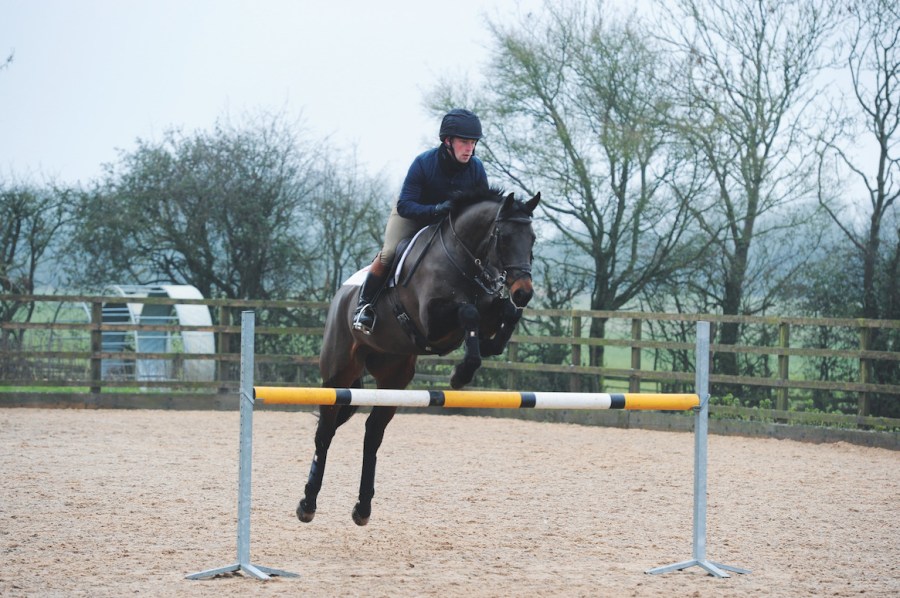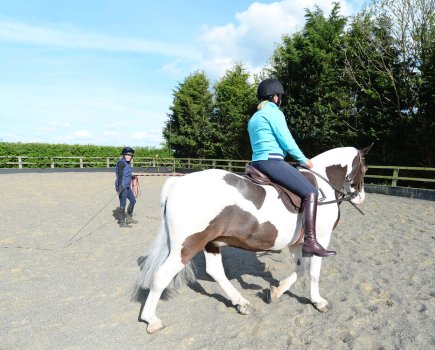With just a few poles and a bit of imagination, you can work on your horse’s rhythm, control and accuracy. Five-star event rider Simon Grieve explains how to make the most of a jumping session with minimal equipment.
You’ll need a minimum of three poles to do these exercises, which you can adapt according to how many poles and wings you have in total.
1 Create a funnel
- Place two poles on the ground, six or seven canter strides apart.
- Practise opening up and shortening the canter, so you have six strides between the poles, then seven, then five.
- Next, switch the poles so they form a funnel on the approach to a small upright or cross-pole to help keep your horse straight.
- If you have enough poles, create a funnel leading away from the fence too, again to test his straightness.
- Think rhythm throughout. Straightness and rhythm are key, whether you’re jumping a single upright or a full course.
Top tip: look up!
Simon says: “Whenever I’m training, I always try to look up at the clouds so that I can ‘feel’ how my horse is going, rather than looking between his ears and obsessing about where he has his head and neck. Try it yourself: look up and you’ll be able to feel much more easily if your horse is crooked, for instance.”
2 Test your accuracy with angles
Depending on how many poles and wings you have, build two or three fences each one of your horse’s strides (about eight of yours) apart. No wings — or blocks or barrels — to put your poles on? Do this with poles on the floor instead.
“For this exercise, you’re going to have to employ your imaginary infrared beam,” jokes Simon. “Pick a line off the long side of the arena, aiming straight for the middle of one of your fences.”
- To test your accuracy when jumping at an angle, pick a line from the long side of the school across one of the fences and really lock on to it.
- Let’s start with the middle fence. Imagine you’re following an infrared beam across the school and over the jump — a beam you need to follow both on take-off and landing.
- Pick up canter and ride around the first fence, turning off the outside track and following a diagonal line over the centre of the middle fence. This will require you to jump it at an angle.
- Ride straight away from the fence to the outside track.
- Try this exercise on both reins and over different fences.
- Play around with where you turn off the outside track so that your lines and the degree of angle change.
- If your horse drifts left or right correct him on landing and then calmly do it again. It’s all about repetition.
- Think about your position too. Are your shoulders up? Are you collapsing over the fence?
- As Simon explains, he often feels crooked while doing this exercise: it’s as much a test of the rider’s straightness as it is your horse’s
Top tip: small arena? No problem!
Only got a small space to train in? “It’s good to have to land and then turn fast — it’s all great practise for jumping a twisty course,” says Simon.
3 Remove the ground poles
If your horse finds exercise two a bit too easy, remove any ground poles you’ve put down.
“This won’t work for every horse, but in my horse’s case it will force him to have to think a bit harder and really concentrate on where he’s putting his feet,” explains Simon.
- Remove any ground poles from your line of two or three fences, keeping the jumps nice and small to start.
- Imagine the funnel of poles is still there on the approach, and concentrate on your rhythm and straightness.
- Jump all three fences in a line; then switch to jumping each of them at an angle off the long side, as in exercise two.









